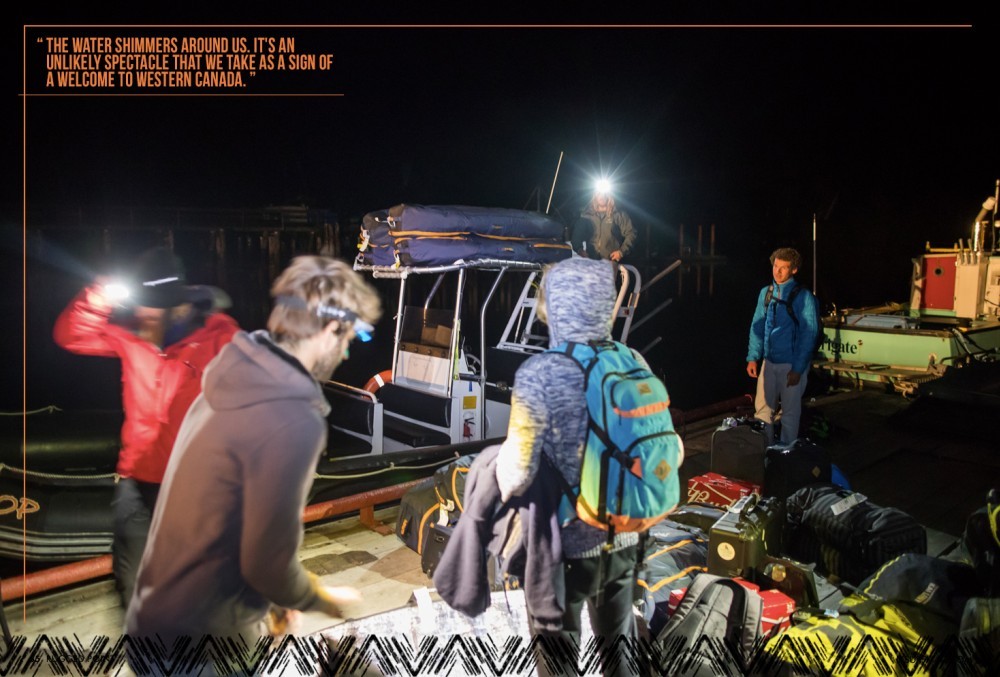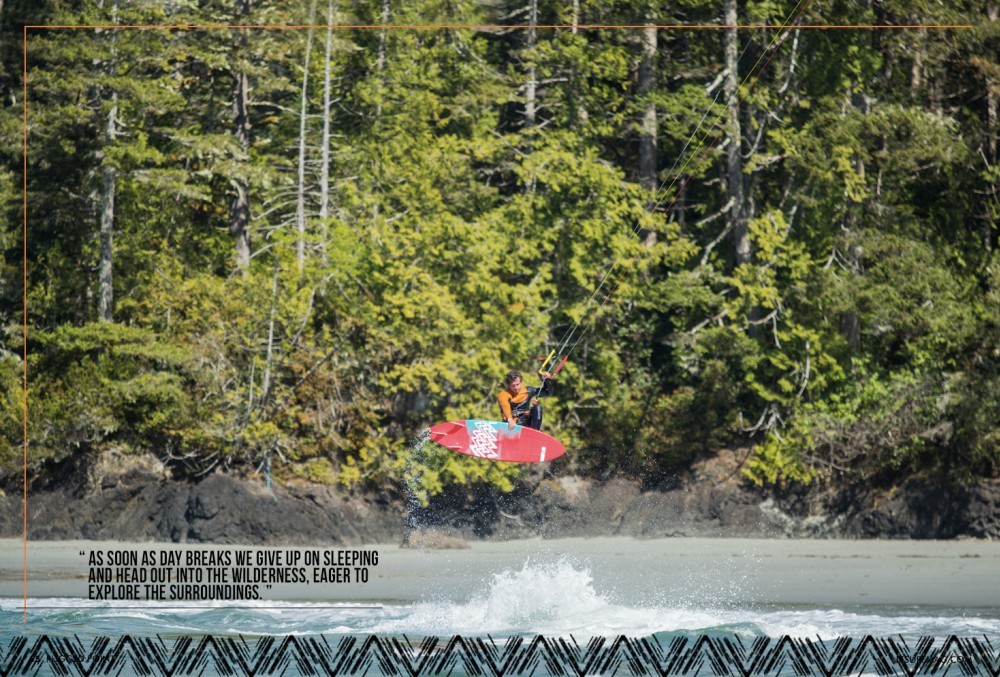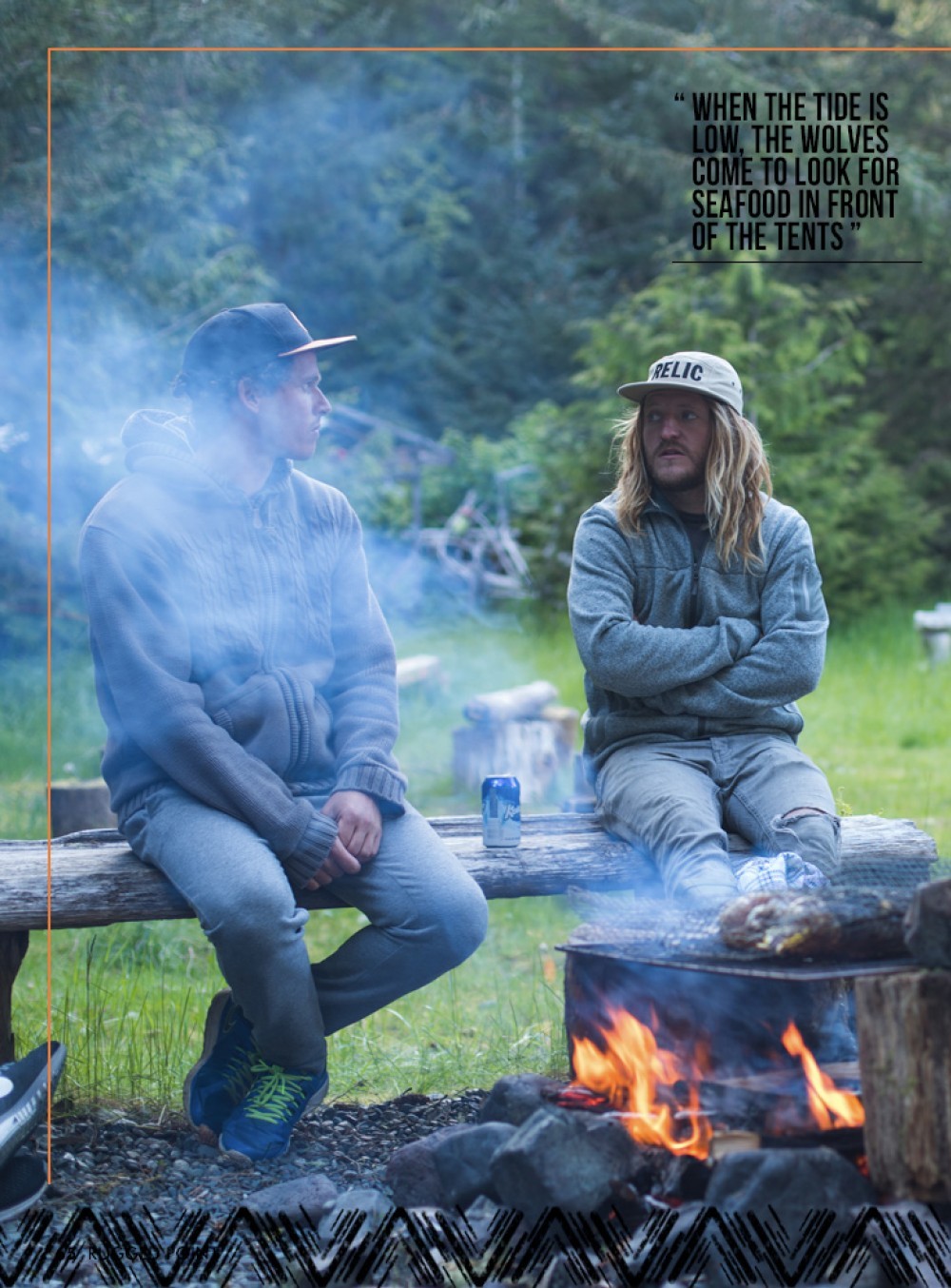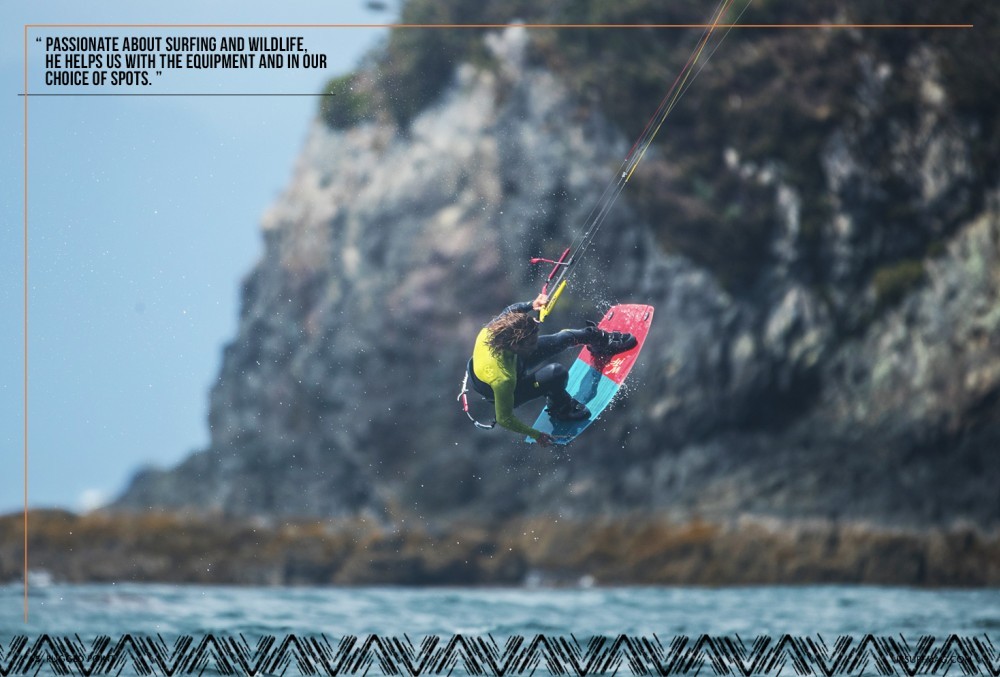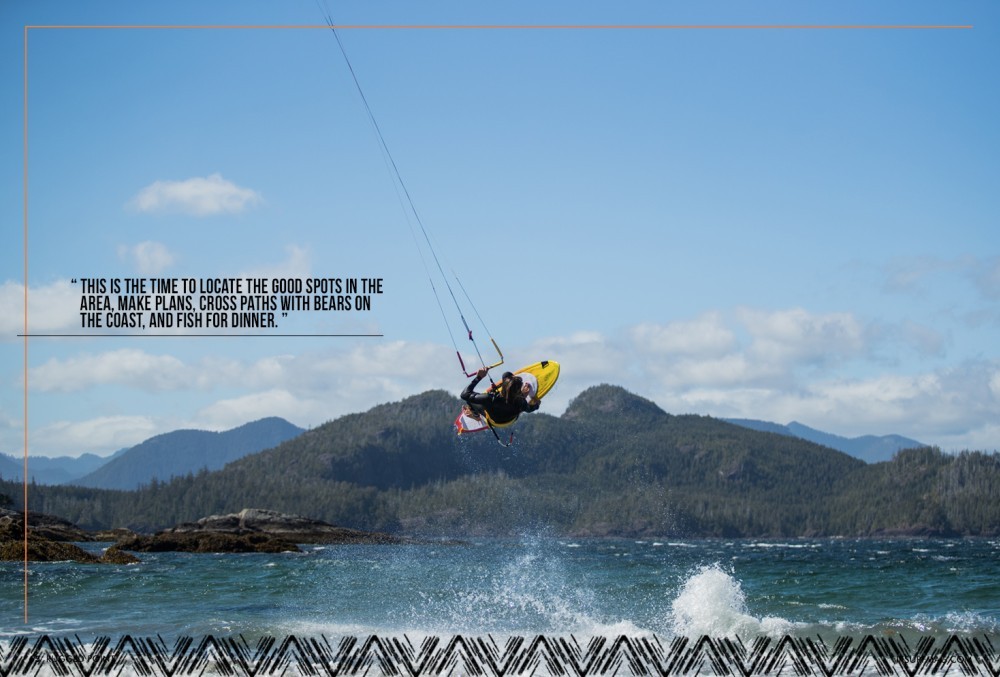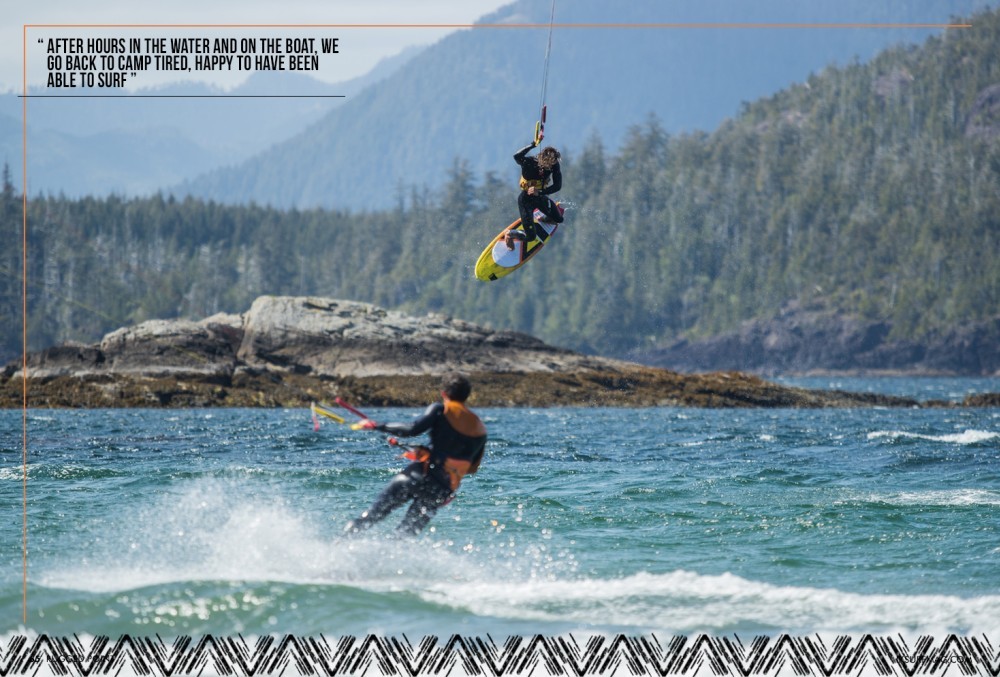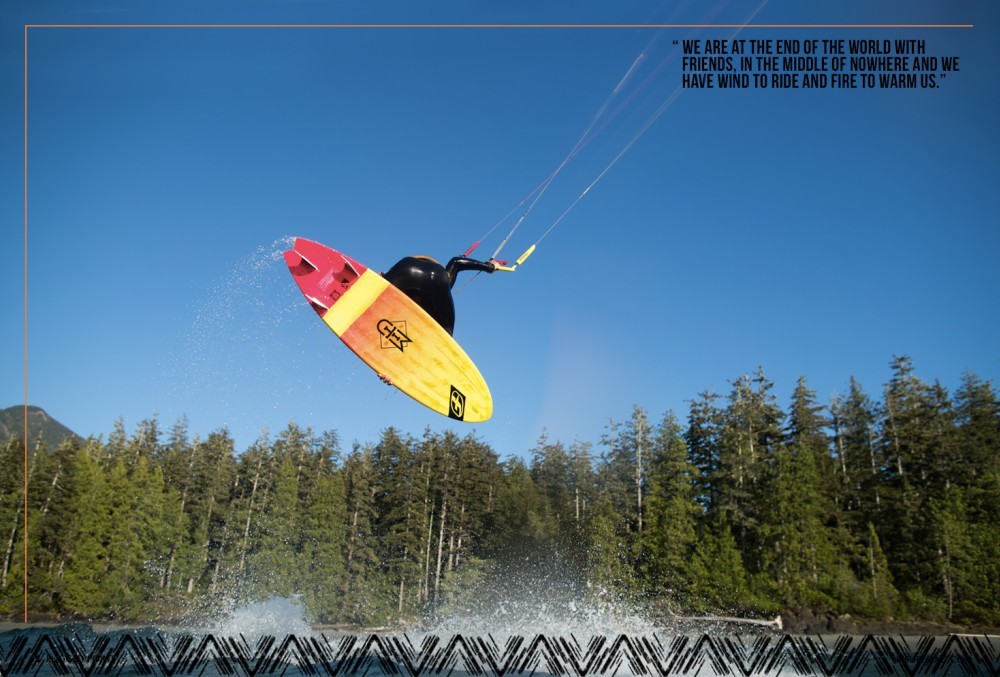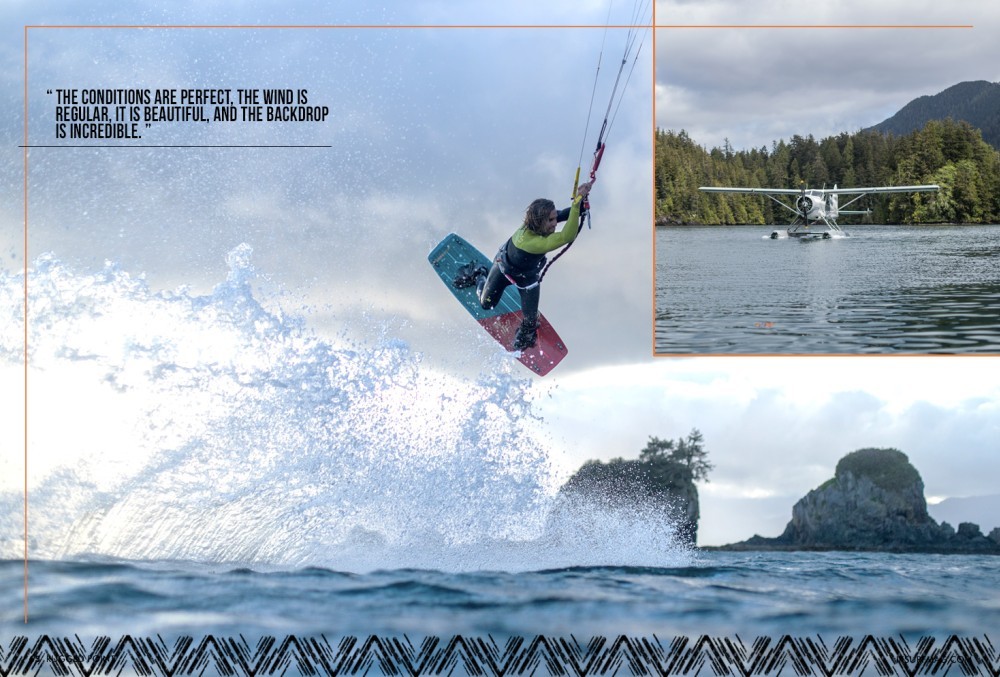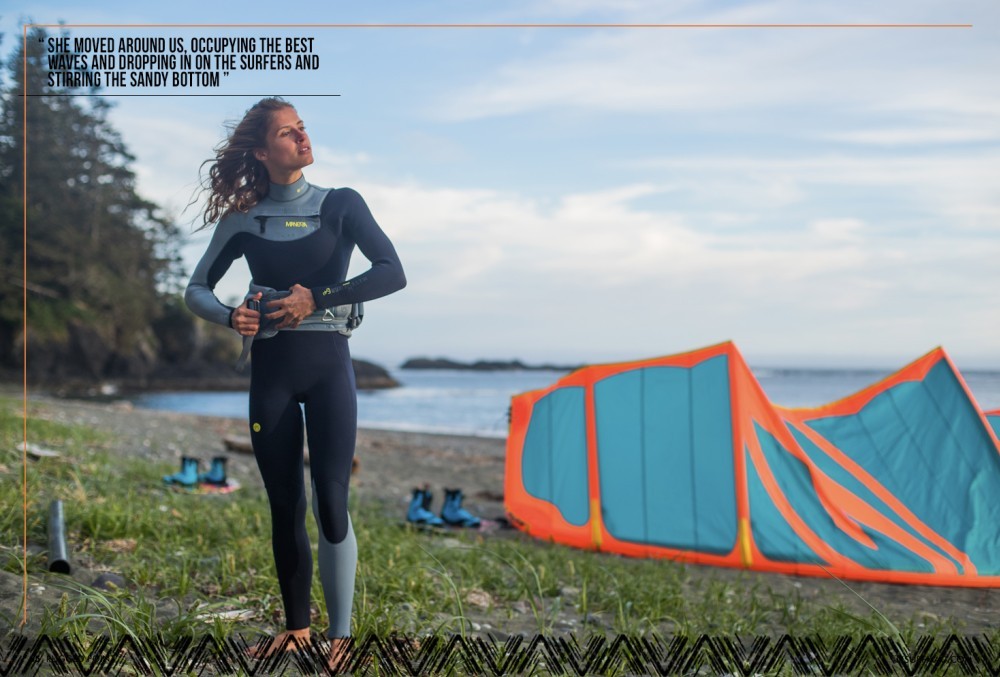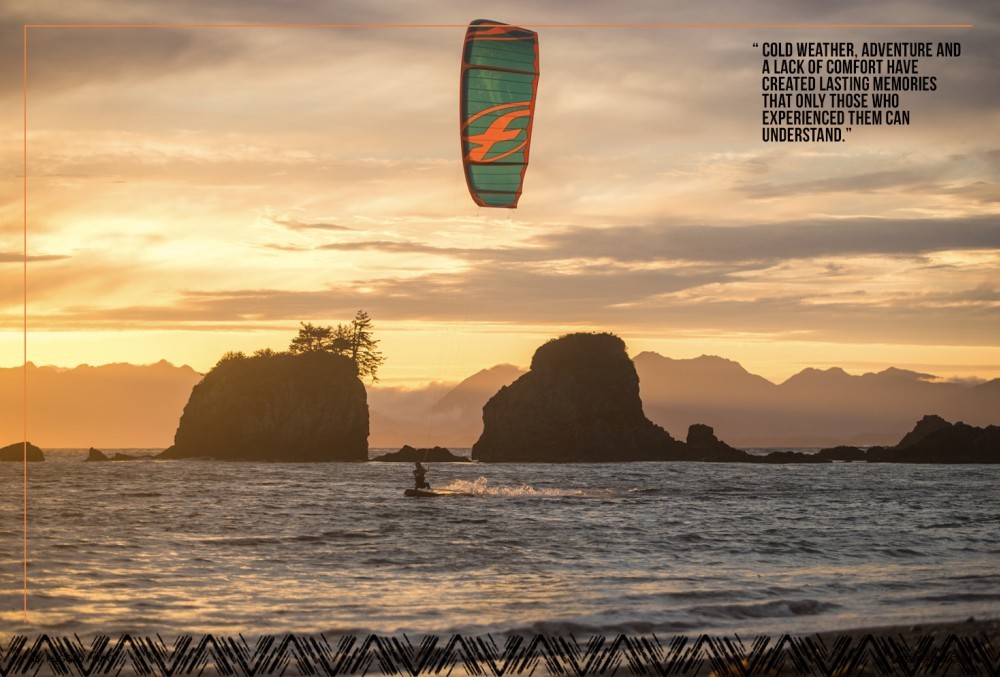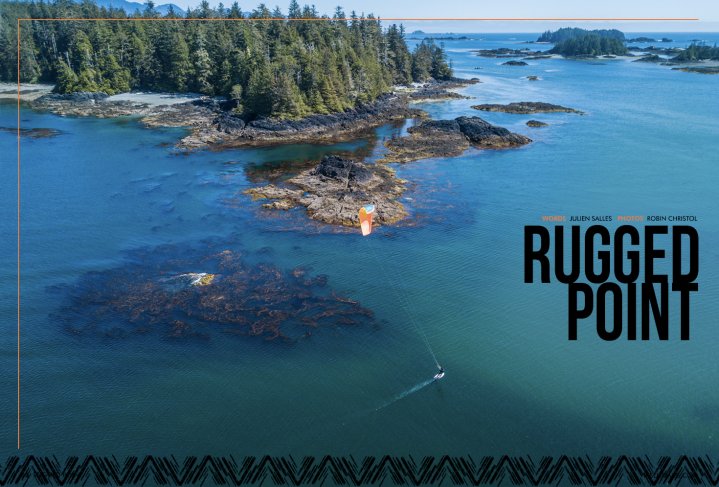
Rugged Point
Issue 65 / Fri 20th Oct, 2017
Find out how the Manera team survived living with wild wolves, freezing temperatures and no electricity as they travel deep into the western wilds of Canada to discover a kitesurfing paradise without any palm trees! Imagine having no phone signal, electricity or running water for ten days in the wilderness, then remember the empty beaches, no crowds and stunning scenery, it’s time to get your shred on!
It's a dark night; we have been travelling for several hours on a dirt road filled with holes, we are exhausted when the brakes on the van screech and we finally stop. Around us stand colossal fir trees. We are in a small clearing at the end of a fjord. There's an old wooden dock where we see a rigged-hull inflatable boat. Two bearded Canadians take out their flashlights, and they dazzle us. These are our guides; Bobby and Phil.
After 11 hours of flying from France, 2 hours by shuttle, 2 hours by ferry, 6 hours on the tarmac and a few hours on the dirt road, we have almost reached our final goal; Spring Island. Now we must load twelve board bags, eight people, three drones, two cameras and a camera case onto the boat so we can get to the spot. We also load up all our supplies and camping equipment for eight days in the wilderness. We packed a lot of beer, and despite the boat being cramped we definitely weren't going to leave that behind!
We make our way blindly through the darkness in the overloaded boat, slaloming between reefs and islands that we can barely see in the dead of night. It's cold, very cold, and it begins to rain a kind of melted snow. We are all hidden under jackets and hoods. Paul and David are wrapped in their sleeping bags in the front, and we try not to freeze. We cast furtive glances around us. We can only just make out the outline of vast forests against the background night sky that is filled with clouds.
Then a brighter, blue haze attracts our attention in the water all around us. We are cruising over a school of plankton, which start to glow as the wake of the boat disturbs them. The water shimmers around us. It's an unlikely spectacle that we take as a sign of a welcome to Western Canada.
As we approach Spring Island, we learn two new pieces of information; The island is just 2km² and is home to about ten wolves, brought here from the coast of Vancouver. For eight days, there will be as many wolves as humans on the island. The second thing we learn is that there is no dock, and we must jump into the water to help the boat manoeuvre and unload all our gear.
With cold, icy feet, we walk up the pebble beach that leads to the camp, arms full of board bags, belongings and of course beer!
Spring Island is a stretch of lost forest on the Pacific coast just off Vancouver Island, located between Brooks Peninsula and Nootka Island. The nearest village in the area is Kyuquot, and it is far from being a metropolis. There is only one grocery store for restocking, and it is only open three days a week, four hours per day!
Our camp is located on the east side of Spring Island in a small sheltered bay. It has a common room made of wood and tarps; it's rudimentary but charming and practical. We sleep in tents at the edge of the forest along the beach, three people per tent. After creating a strategy to avoid snoring riders, some realise that they have forgotten their inflatable mattresses, and so end up sleeping on piles of worn board bags and wet ponchos throughout their stay. This isn't the kind of place where you can just drive back and grab things you forgot, or just take a trip to a store to buy them!
There's no shower, but two great 'toilets' with 360° views of the forest. The only modern comfort we allow is a small generator to charge the batteries for the cameras and drones.
Our first night is a baptism of fire; the wind is blowing, it rains on the tent and jet lag makes sleep difficult. As soon as day breaks we give up on sleeping and head out into the wilderness, eager to explore the surroundings.
Hardly any humans visit the island, flora and fauna have been allowed to develop at its own pace with minimal input from man. When the tide is low, the wolves come to look for seafood in front of the tents, royal eagles nest in the pines above us, and otters float peacefully on their backs in the camp's small sheltered bay.
This kind of trip requires a lot of patience and physical resources. Comfort is rudimentary, and you shouldn't expect a good hot shower after the session. We left with a small, motivated team of riders Pauline Valesa, David Tonijuan, Paul Serin, Camille Delannoy & Etienne Lhote provide a mix of world class freestyle and strapless skills. Olivier Sautet and Robin Christol are here to create all the media for the trip, Olivier is tasked with creating the new Manera film while Robin is shooting all the stills.
Our three guides each have a speciality:
Bobby is the boss of Wild Pacific Expeditions. He runs expeditions all over British Columbia, usually by boat. He knows the coast and the right spots and takes us there in his RIB. He's a surfer, and he understands how we need to shoot our images.
Phil is from Quebec. Years ago one evening when the surf was rubbish on the east coast, he decided to go to the Pacific coast. The following day, he hitchhiked across Canada to reach Tofino. Passionate about surfing and wildlife, he helps us with the equipment and in our choice of spots.
Rowan is a pure local. He's been on expeditions in the Vancouver forests since he was very young. He knows the fauna, the flora and the island in general. He guides us on land and manages the logistics.
With no cell reception, we have to listen to the weather reports on a specific radio frequency. The wind is predicted to be low and NW, but strengthening throughout the week. So we set off to explore the W/NW coast of the island to look for a spot.
The forest is an untouched ecosystem. We follow a small path crossing the island, and the many trees that have fallen across it make the walk challenging. We need about 20 minutes to reach the other side. Crossing through the last fir trees, we emerge onto a large sandy beach; it is perfectly exposed to the predicted wind.
Islands and reefs form a barrier around the bay, high enough to protect it from the chop, but low enough not to break the wind. It seems very promising! The spot is beautiful. The beach and the islands are lined with huge pine trees. As the sun sets we see the Brooks Peninsula in the distance, all we need now is the wind!
Four days of exploration follow, searching for the wind. We wander between the Brooks Peninsula and Rugged Point, but there is nothing to be done. We don't even get to put a fin in the water. The wind is blowing at around 5 knots, and the ocean is flat. This is the time to locate the good spots in the area, make plans, cross paths with bears on the coast, and fish for dinner.
In our spare time, we end up building a slider! The Vancouver beaches are filled with clean, well-cut logs, which at first glance seems odd. Rowan explains that the sawmills transport their wood by sea, and sometimes some trunks escape during transport, so they often end up stacked on the beaches.
This makes it very practical to build a fire almost anywhere, although it can be very dangerous for the boats in the area, and seems not too bad for sliding over with a board. We spent hours setting up this trunk on a small island, only to never have the right tide with the right wind to use it. It will probably always be planted in the same place, and fishermen will always wonder how the sea was able to arrange the trunk in this strange position!
At the end of the fifth day, we finally manage to get wet. A decent sized swell is on its way, and it should wrap around Brooks far enough to reach a decent beach break we have spotted. The wind should rise in the evening, so we opt for a first SUP/Surf session. We head out early in the morning to the Brooks Peninsula.
After a short boat ride along the coast, we arrive at a bay in the south of the peninsula. We are just behind the peak. The swell looks small, and we start to lose hope. Suddenly Bobby accelerates the boat sharply to avoid a beautiful set that comes in. The swell rises, breaks and runs along the beach!
Five short minutes later, we are all in the water, at the peak, ready to surf our first waves in British Columbia. The water is translucent blue, and the waves roll right along a rocky cliff. We remain in the water a few hours, then a few gusts of wind begin to come in, announcing the start of our first kite session.
We sail to Brooks Point, where the wind and the swell hit the coast in full force. A group of unruly sea lions are waiting for us, and there is a right-hander peak that looks good. The wind is light but useable, Etienne and Camille rush to the water for a wave session. Annoyingly though we film because the boat can't approach the wave close enough to get a usable angle.
After hours in the water and on the boat, we go back to camp tired, happy to have been able to surf, but a little frustrated by the kite session and the lack of images. Time is running out, and we have a huge list of shots and clips that we want to get on film.
On the 6th day the conditions seem more promising, with a much stronger wind expected, we decided to spend all day on the west coast of Spring. We pack things for lunch and dinner, and we go through the forest. We make a big fire to warm ourselves and wait patiently for the wind.
The wind is gusty and cold, blowing between 15 and 20 knots, several stronger gusts hit us on the beach, and the wind is an on/off affair. The riders take turns in pairs, David and Pauline then Paul and Camille. Two warm up around the fire while two are in the water. It may be our only windy day, so they do a series of sessions from noon until night. The conditions are rough but we wear smiles, we are at the end of the world with friends, in the middle of nowhere and we have wind to ride and fire to warm us.
We cross the forest one last time to return to camp. The freestyle session is a wrap!
On the seventh and last day for us on the island, we look for strapless conditions. At breakfast in front of a map of the area, we talk with Bobby to find out which spot will get the most wind.
We choose to head to Rugged Point, a natural park just southeast of Spring Island.
The swell is up, so we pass inside the fjords to reach our destination, and we notice immediately that the wind is finally blowing consistently. The Venturi effect is at work, and Rugged's peninsula is getting hit by a stable 20knot breeze on the beach on the North side. Etienne and Camille rig up and get in the water. The conditions are perfect, the wind is regular, it is beautiful, and the backdrop is incredible.
The fjord's chop creates small kickers. Camille claims the double-front roll and Etienne gets some good aerials; then the session ends on the beach to grill corn on the fire. This is our last night in the wilderness. Tomorrow we head off to Tofino, further south of Vancouver. The evening ends at the camp, around the fire, with beers in hand, to discuss these privileged moments we have enjoyed amongst nature.
We spent all our evenings discussing, debating, laughing. We were a lonely group with no one for miles around, but we never had a lonely moment. As there was no cell reception, no one had their eyes on a screen, a rare treat to truly interact without the pull of the digital world. We lived completely in the moment, enjoying the luxury provided to us by British Columbia. We lived in tents, smelling the seaweed and going to the loo just like a bear would, in the woods. This return to the quasi-savage state does us good. It rejuvenates and helps us take a step back from our everyday life.
It is noon on the eighth day. A seaplane lands and six of us embark for Tofino, a surfing village further south of Vancouver. Bobby, Rowan, Phil, David and I set out on a boat with all the gear. We head to our port of arrival, and we will drive for 6 hours to get to the others.
We are doing a three-day stop to Tofino because there are several very well-oriented bays for the wave conditions. When we finally joined the others with David, everyone was already under the spell of the place and tried to convince me to move the MANERA headquarters here!?!
Indeed, the village seems timeless. Surfing is present everywhere, and there is a kind of modern hippie atmosphere. We head to the beach in the back of our rented vans. But despite all our research, the wind will not meet us there. We spend time in the water surfing, waiting for the slightest gust, but nothing happens. However, it ends up being glassy every day.
We were surfing south of Long Beach when we saw Olivier's drone passing over us, which is strange because we hadn't planned a surf shoot.
Suddenly a powerful spray erupted from the surface of the water, billowing towards the sky. A whale! She wasn't more than ten meters from us, and we hadn't even noticed her. She moved around us, occupying the best waves and dropping in on the surfers and stirring the sandy bottom to find something to eat. It was a great departure gift.
We finish the traditional final evening on the premises of the Tofino Brewing Co, with some local salmon sushi and a Beer-pong table. It's a great way to end what has been an unbelievable trip.
In the plane, it is time to take stock and find the answer to the question: "How was the trip?" Epic, awesome, incredible?
The truth is that it was indescribable.
We ended up on Rugged Point Beach, unwinding our kite lines over bear tracks. One morning Etienne found his neoprene boots devoured by the wolves. We surfed with a whale...
Even if the conditions are sometimes rough, changeable and unpredictable, we won't swap our seats for a better, more well-known destination. Cold weather, adventure and a lack of comfort have created lasting memories that only those who experienced them can understand.
Our minds still shiver at the memory of these sessions; our hands are still shaking from the frozen memory of that water, leaving this place is hard.
Back home things haven’t changed, but we most certainly have...
Videos
By Julien Salles




